RECOIL OFFGRID Survival Winning the Germ War
Pick your favorite (or least favorite) disaster scenario and ask what your top priorities following that disaster will be. Are a clean body and living space on your list? They should be.
Sanitation and hygiene are fundamental forms of preventative medicine to block disease transmission. Human waste and household garbage harbor numerous infectious diseases. Properly disposing of these items and maintaining clean bodies are staples of the modern running-water world. With a flush of the toilet, taking a can to the curb, the turn of a knob, a little soap, and a few seconds, most of our sanitation and hygiene is handled effortlessly — so much so that very few of us ever consider life without these conveniences.
History shows that in disasters, one of the first things to become compromised is the infrastructure we rely on for hygiene and sanitation. The power goes out, and pumps shut down. Water lines are broken or compromised. Essential personnel to maintain infrastructure services fall ill or are unable to reach their workplaces. No matter the scenario, one of the greatest disaster challenges is maintaining clean and healthy living conditions. Meeting needs for clean water, sanitary waste disposal, and individual hygiene tops the list of priorities for every disaster response organization. Many tasks come later, or simultaneously, but without these fundamentals, the spread of disease runs unchecked.
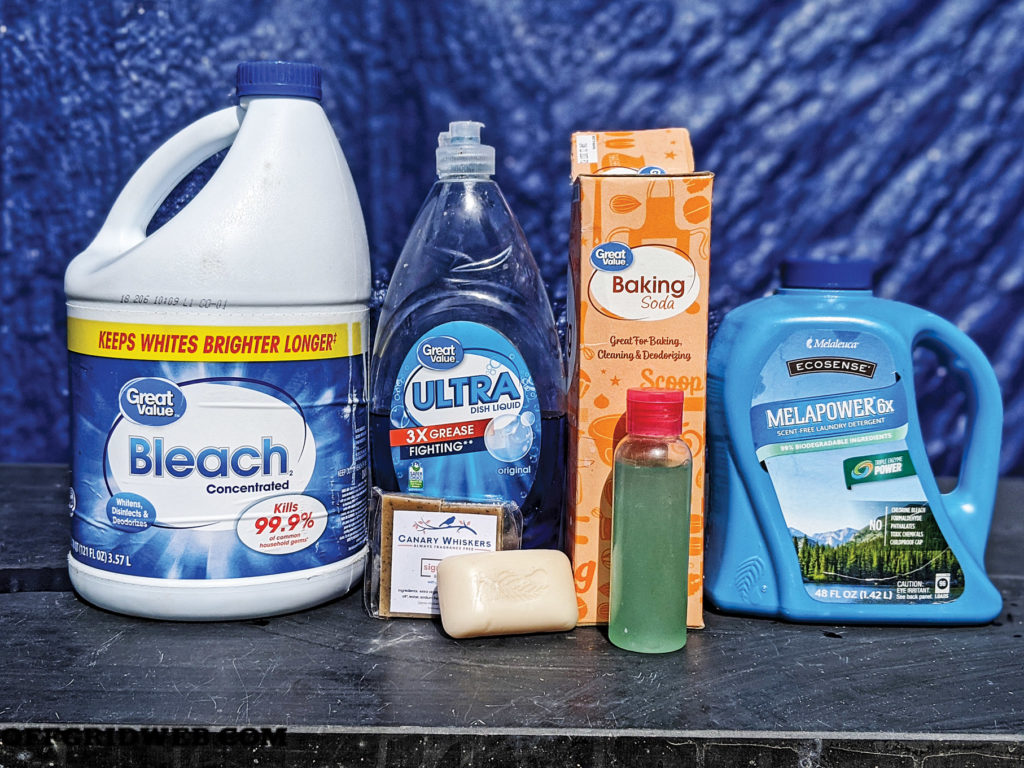
Above: The household cleaners and soaps you already have can work with improvised hygiene and sanitation methods. Separate into smaller containers for rationing to group members.
Sanitation means keeping environments clean and healthy. Hygiene means keeping the body clean and healthy. Disease risk from unsanitary conditions and poor hygiene can be extreme, as bacteria, viruses, and other pathogens not only thrive in dirty environments but can be spread more easily.
Of primary concern is the transmission of diseases via the fecal-oral route, where pathogens in human waste pass from one person to another and are ingested. Diseases and pathogens that can be found in human solid waste include cholera, shigella, e. coli, hepatitis, giardia, cryptosporidium, tapeworms, amoebas, and even the SARS-CoV-2 virus. Fecal-oral transmission occurs most readily in environments where human waste cannot be dealt with appropriately. Pathogen-containing particles can be carried by unwashed hands and insects like flies to other people, uncovered food, shared water, and other items. Human waste above ground can be carried by run-off to contaminate waterways. Buried human waste can soak into the ground and contaminate below-ground water.
Trash is also a concern, as many of the items we throw away can rot, grow bacteria, and attract insects. Food wastes are a particular concern. Food itself can also be a culprit for disease spread, as without ready means of preservation, food can spoil and host a cornucopia of nastiness, including toxic spoilage-produced waste products, such as botulinum toxin.
To manage these concerns, we must plan for providing sanitation and hygiene in a disaster.
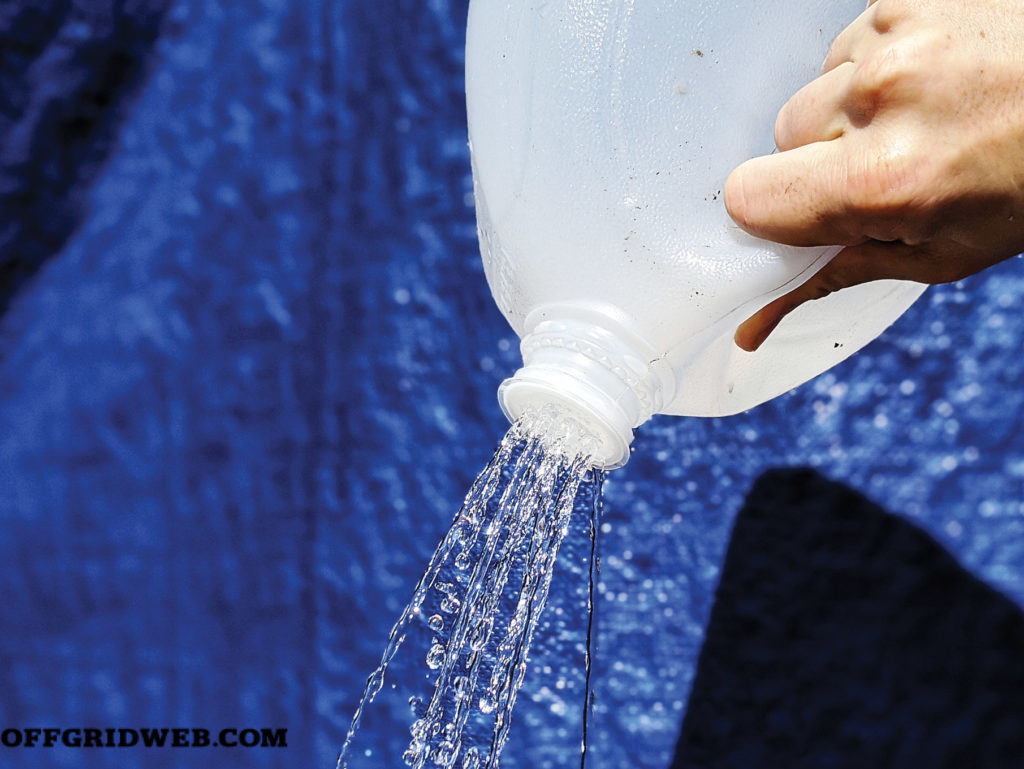
Above: A gallon jug with the lid drilled or perforated in multiple spots can be mounted on a rod to tip, by hand or with an attached cord pull, to wash hands or even shower under.
Nearly everything in this article requires having clean water. Without clean water we are lost, regardless of the other severity of our situation. Entire books can be written on this subject, and to cover sanitation and hygiene we don’t have room to take a deep dive into water. If you take nothing else away from this, take away a desire to research water storage, emergency water access, transport, filtration, and purification.
For the majority of Americans, water comes from the tap. Some of us may buy purified water to drink, or have filters in our kitchen, but most of our water comes out of the faucet without thought. Implicit in this arrangement is that we have very little water storage. The toilet tank, the hot water heater, and maybe a rain barrel or two if we have a yard — that’s it. If the municipal water systems are disrupted, accessing more water will become a challenge. The World Health Organization recommends access to 2 to 4 gallons of water per person, per day, for disaster response provisioning. Those “native” storage resources in the home will supply that only briefly. You need to identify water sources in your area now, before something happens, and think of ways to transport, purify, and store that water.
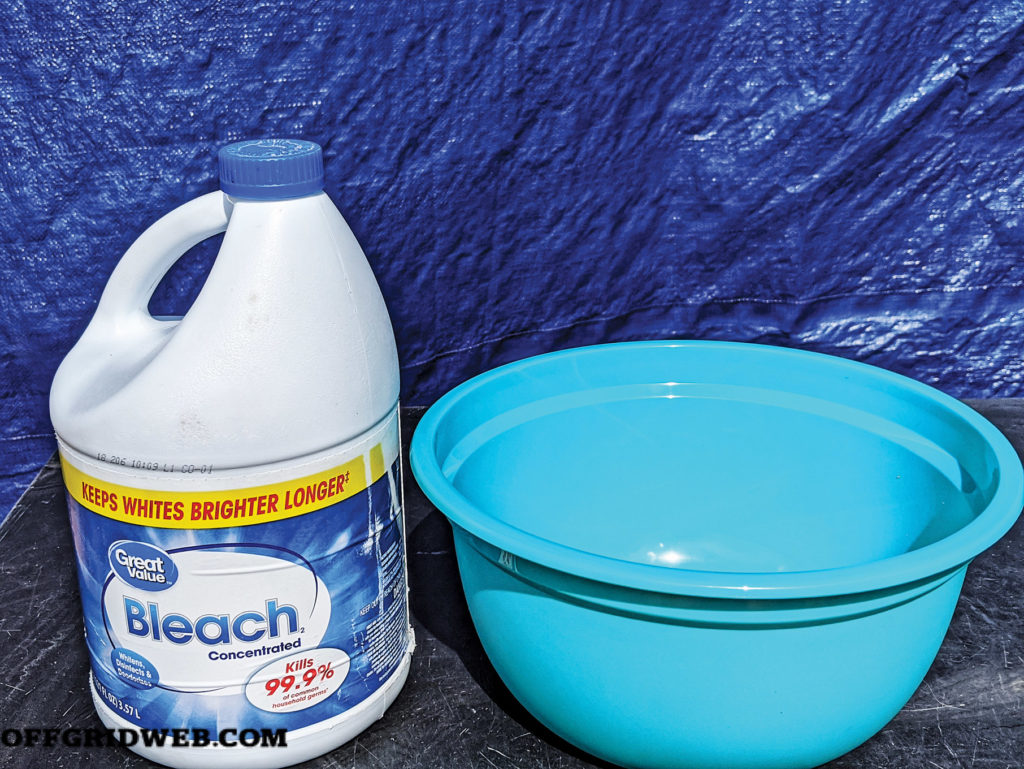
Above: Wash bowls filled with 1 tablespoon of bleach to 1 gallon of water can be reused repeatedly for washing your hands.
Fundamental to our discussion of hygiene and sanitation is using bleach (sodium hypochlorite) to disinfect water. Although bleach cannot remove particulate contaminants, it can render water safe for use. Only a few drops are required for potable water, around eight drops per gallon. To make a cleaning solution of water and bleach, use 1 tablespoon per gallon. Only use regular sodium hypochlorite bleach; avoid scented, additive-containing, or color-safe bleaches.
History has shown time and time again that good personal hygiene helps to prevent disease and maintain health. Though the disaster environment may make it difficult, your immediate survival and long-term success are affected by your hygiene.
Critical among personal hygiene tasks is hand washing. Pathogens from anything we touch can linger on hands and be transferred to mouths, eyes, food, and water. The barrier to this is hand washing with soap and water. We’ve all heard it a lot recently: Thoroughly lather palms, backs of hands, and fingers and scrub for at least 20 seconds under running water. Complication? You have to have running water.
Buckets and jugs with a spigot attached are the most apparent solution to creating a faucet. Turn the spigot and wash as normal. A towel can be used to turn the spigot off, or it can be washed as you wash. A larger vessel underneath can capture gray-water. Simpler systems can be created using plastic jugs filled with water and rigged up to tip slightly, running out water without spilling and returning upright by gravity. You can also create a reusable hand-washing basin with a large bowl filled with a solution of water and bleach. The aforementioned 1 tablespoon of bleach to 1 gallon of water is the right ratio. Refresh the bleach when you can no longer smell chlorine in the water and refresh the whole thing after several uses.
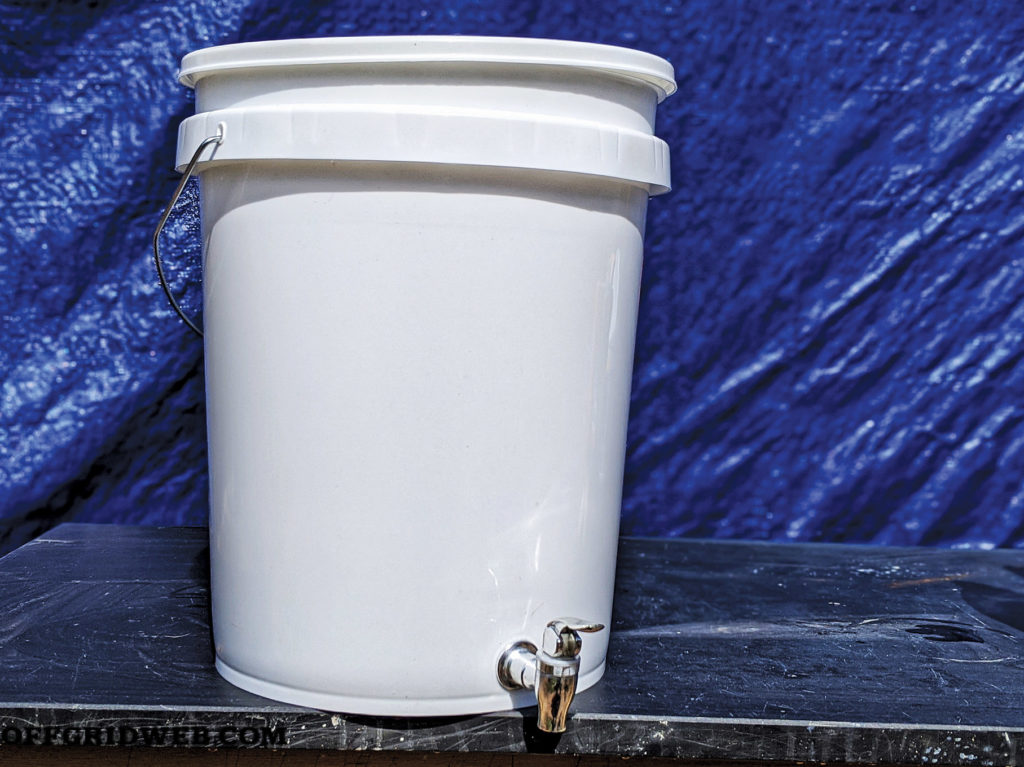

Above: Many buckets or other containers can be easily drilled out for attaching a spigot and used as an ad hoc faucet.
You must wash your hands after going to the bathroom, disposing of waste or trash, manual labor, or changing a diaper, and before providing medical care, preparing food, or eating, touching another person intimately, and any other time your hands might be contaminated. These common-sense rules are even more important to remember during a disaster.
The next step is keeping your body clean. Sweat attracts dirt, and unwashed bodies are ready hosts for various infections. The easiest, and least water-consumptive method is to take a “bird bath” using a bowl of water, soap, and a washcloth. Wash with the soap and cloth, and lave clean water with a dipper to rinse. While far from the most effective, this will meet the basic requirements of washing the face, armpits, crotch, and feet.
More proper bathing can be performed using portable camp showers. A heavy-duty water bladder that hangs above head height with a gravity-fed tube and shower head, these are designed to hang in the sun for heat. Hanging on a balcony or in a window, rather than fully outdoors, may only get partial sun, but will at least take the chill off. Improvised showers can be made using the same idea. Insert a spigot or tap in the bottom of any water container, with a hose running to a shower-head type fixture, be it a garden sprinkler or something improvised (a water bottle with holes in it, capped and drilled PVC pipe, or a cannibalized shower head). Use caution hanging heavy containers and make sure whatever you use can bear the weight of several gallons of water.
Another means of improvising a shower is to use a garden pump-sprayer. You must use a clean sprayer and not one that has ever had herbicides or pesticides in it. Just fill with water, pump, and spray. You can even set your sprayer in the sun for several hours to warm the water first. Baths should be avoided as they use excessive amounts of water. Wet wipes can be used for quick and minimally effective hygiene of critical areas, but are less effective and more wasteful than soap and water.
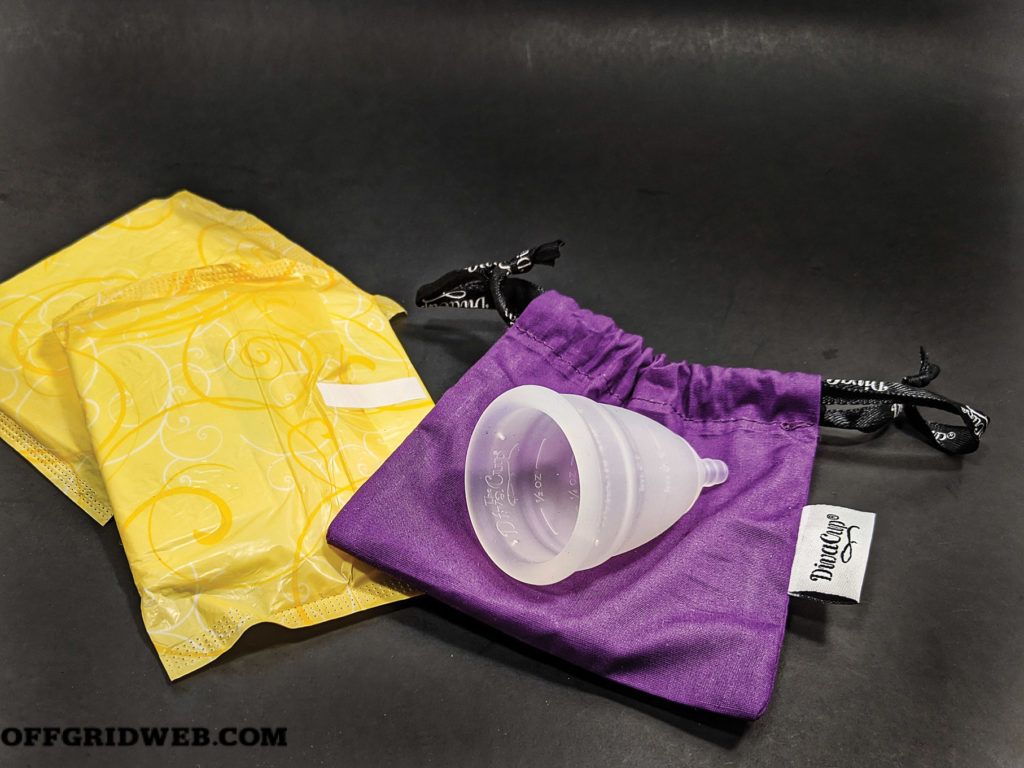
Above: Menstrual cups present a long-term reusable alternative to pads that can be extremely valuable in disaster environments.
Routine hygiene must be maintained too. A disaster is no excuse to stop brushing your teeth. Toothbrushes are cheap, especially bulk disposables such as those used in hospitals. Toothpaste too, though in an emergency baking soda can be used in place of toothpaste. Extra or worn out toothbrushes can be sterilized and reused to clean hands and cuticles. Fingernails should be trimmed to avoid breaking and injury, as small wounds on the hands are very susceptible to infection.
The next point of hygiene to take care of is bodily functions. As with different washing strategies, we must be willing to adapt. Realize that while none of these measures are convenient or comfortable, done right they achieve the goal.
Since a post-disaster run to the store is an unlikely hope, you’ll need to be stocked up on reusable hygiene supplies, or prepared to improvise them. Washable cloth menstrual pads, and reusable menstrual cups, are a long-term replacement for unavailable disposables. If caught unprepared, cloth pads can be easily sewn from absorbent materials with a nonabsorbent backer. Improvised pads can be made from household materials. Rectangles of cotton wool or similar can be wrapped in a layer of soft cotton, or a thin rectangular fold made of absorbent fabric. A thin plastic liner, between pad and underwear, can prevent leakage. Ensure you have or make enough to change frequently.
If you have young children, you may already be cloth diapering, which puts you ahead of the curve in a disaster. If not, now would be a good time to begin. Receiving blankets, which most parents have, make an excellent improvised diaper. Soft cottons, like T-shirt material, also work.
Maintain good hygiene for your little one and clean them gently but well when changing. Baby wipes would be ideal, but soft washcloths dampened with warm water work, and go right to the laundry with cloth diapers. For diaper rash, you can use coconut oil or petroleum jelly as a barrier paste.
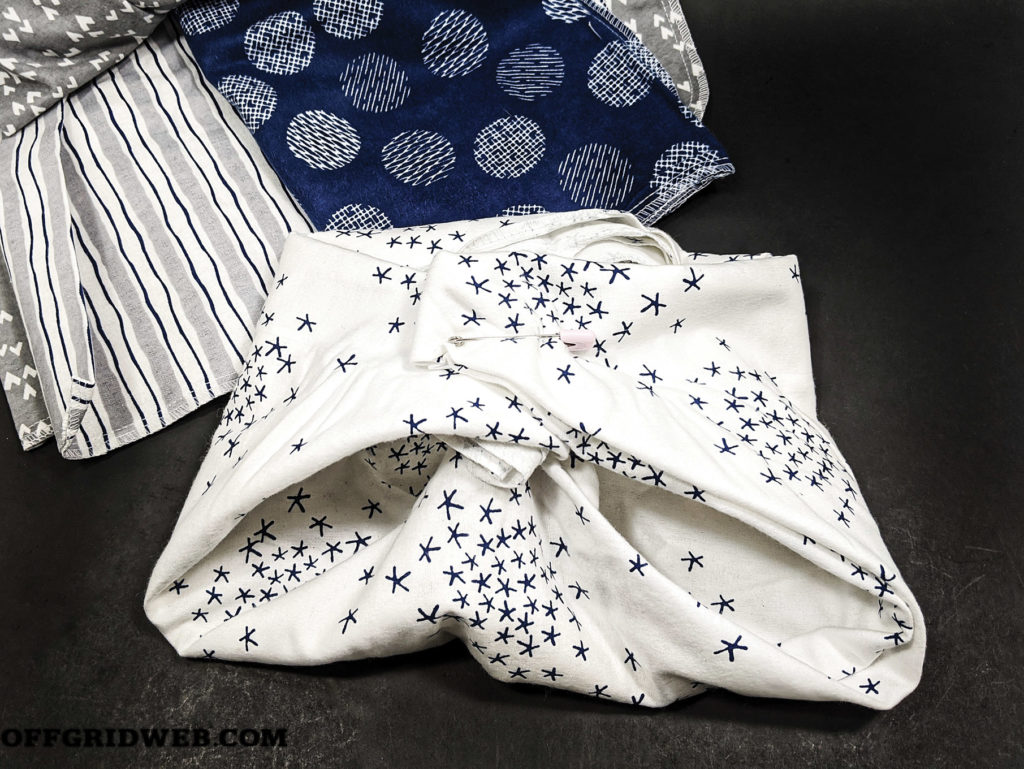
Above: A receiving blanket can be folded and used as a diaper.
Keeping yourself clean after going to the bathroom is as important as keeping your kiddo clean. Again, you’ll have to improvise. Frequent campers know the natural materials that can stand in for TP, but good leaves and dry grass bundles may be in short supply in urban environments. Newsprint and similar paper can be crumpled and flattened repeatedly to soften it, for a less unpleasant experience. Rags can be used too.
Your hand is an option, along with a stream of water, followed by a thorough washing. If you have the water, a bidet can be improvised from a pump sprayer, as discussed for showering. Travel bidets, basically a squeeze bottle with a spray nozzle, can be purchased now and cached. Squeezable sports bottles with push-caps make a solid improvised bidet.
All the good hygiene in the world won’t help if your environment lacks sanitation. Just because you cannot flush or take the trash to the curb every Thursday doesn’t mean waste production stops. Human waste, food waste, and trash will continue to be produced. If these outputs aren’t dealt with, they pollute and lead to the spread of disease.
Top priority is dealing with human waste, as it is the most likely to spread disease. Our goals should be to remove all wastes from the household/living quarters as soon as possible. An indoor bathroom is hard to beat for comfort and morale, but making this work requires some adjustment. If the sewer lines are unbroken, you can activate most flush toilets by pouring water into the bowl. Urine can be left in the bowl, to reduce water use, until solid waste needs to be flushed. A large jug or pitcher can be staged in the bathroom, pre-filled with water, for this purpose. This is an excellent use of gray-water captured elsewhere.
If the sewer lines are compromised, or water availability low, the home toilet can still be used. Line the toilet with garbage bags, ideally doubled, and secure them under the lid. This may be used as normal, and when full, the entire bag simply lifted out and tied closed. Unpleasant odors and flies can be managed by topping each deposit with RV toilet sanitizing chemicals, wood ash, sawdust, cut grass, hay, or alfalfa.
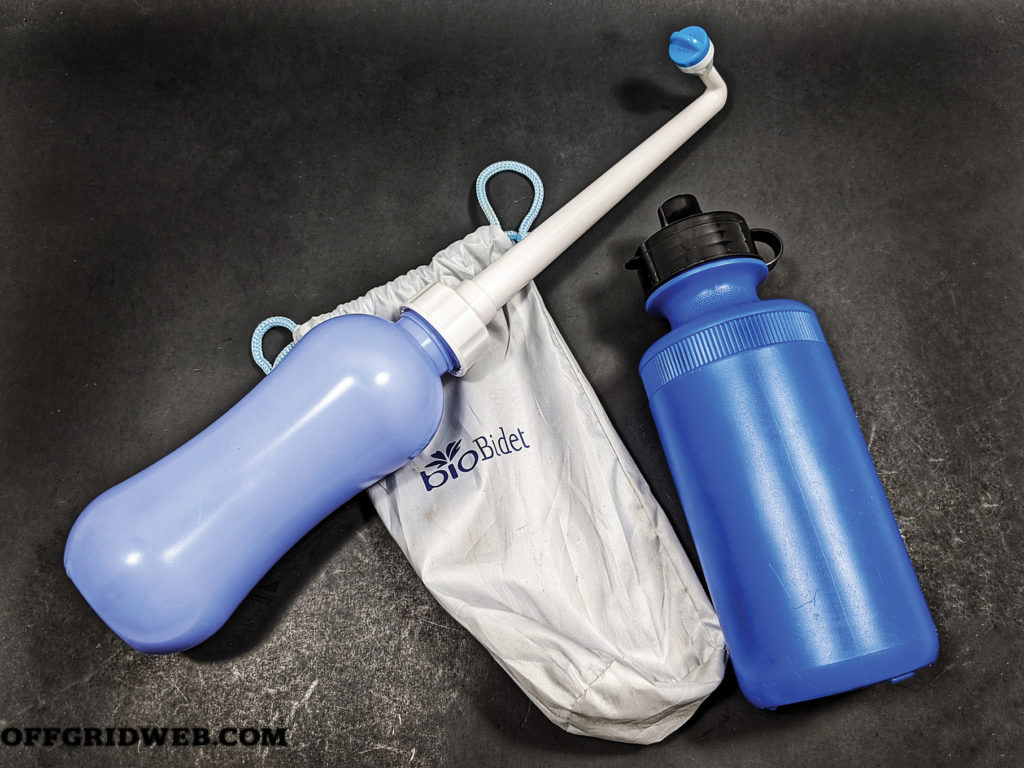
Above: Hand bidets and squeeze-bottles can be kept near, or brought to, bathroom facilities.
The next option, which can still be in the existing bathroom, is to use a portable camp toilet. A five-gallon bucket with an improvised toilet seat frame is almost the same thing. Bucket toilets should be lined with a garbage bag, and material spread over deposits. Empty bucket toilets when they are half-full to avoid a mess.
With any container toilet, effort should be made to deposit only solid waste. Liquids fill bags faster, add weight, and can leak. Urination outside, or even in open drains, can provide an alternative to filling the toilet with liquids. In the long term, areas used for urination should be sprinkled with disinfectant to keep down odors.
You can also set up an outdoor toilet area in many ways, some better than others. An immediate first choice is to use a bucket system. For many caught in a disaster, however, the only choice ends up being various forms of trench or pit latrine. These systems are holes in the ground, dug deep enough and long enough to accommodate days’ or weeks’ worth of deposits from the entire group. Outdoor latrines create significant health hazards unless built properly, as there’s more to them than simply digging a hole and using it.
Latrines can leach into the ground, eventually contaminating ground water, as well as attracting insects that can carry pathogens out of the waste. To mitigate this, latrines must be away from any water sources, open water, dwellings, food prep areas, and showers. The minimum safe distance is 100 feet; 200 to 300 feet would be even better, but even in larger suburbs that distance may not be available in the backyard. In dense urban settings, this may require cooperation to utilize a local open space for community latrines.
You can dig a single deep hole, or a long deep trench, for a latrine. Trench latrines serve more people, or serve fewer people for a longer duration as you move from one end of the trench to the other. Latrines should be deep enough to have 18 inches of soil above the waste when filled back in. They can be equipped with a pair of boards across the pit for squatting over the hole, or made more comfortable with a seat frame, toilet seat, and privacy screens. Each person should cover their deposit with appropriate materials. When the latrine is filled to 18 to 20 inches below the ground level it should be buried and a new one dug.
If you use bucket toilets, or bags lining your indoor toilet, disposal of each full bag becomes the next priority. For a short duration, a tightly sealed garbage can works for a disposal station. It should be lined with heavy garbage bags, with shredded or crumpled paper between bags to absorb moisture and reduce odor. Bags of waste can be added to the can, and the lid tightly sealed each time. A locking lid, or other means of animal proofing the container, is a must. This must be kept a safe distance from water and living areas, and should be fastened tightly to a post or tree to prevent knocking over. In the longer term, disposal pits can be used with depth and placement constraints similar to a latrine. Waste bags should be buried immediately to prevent insect or animal access, reduce smells, and prevent infection.
Food waste and other trash is the next sanitation issue. Trash attracts bugs and animals and can be a festering ground for bacteria and disease, just like human waste. Separate your trash by wet and dry. Wet trash includes food waste, containers with food remnants, and so on; it should be handled similar to human waste. Dry trash is paper, clean containers, and the like; it can be contained with somewhat less concerns.
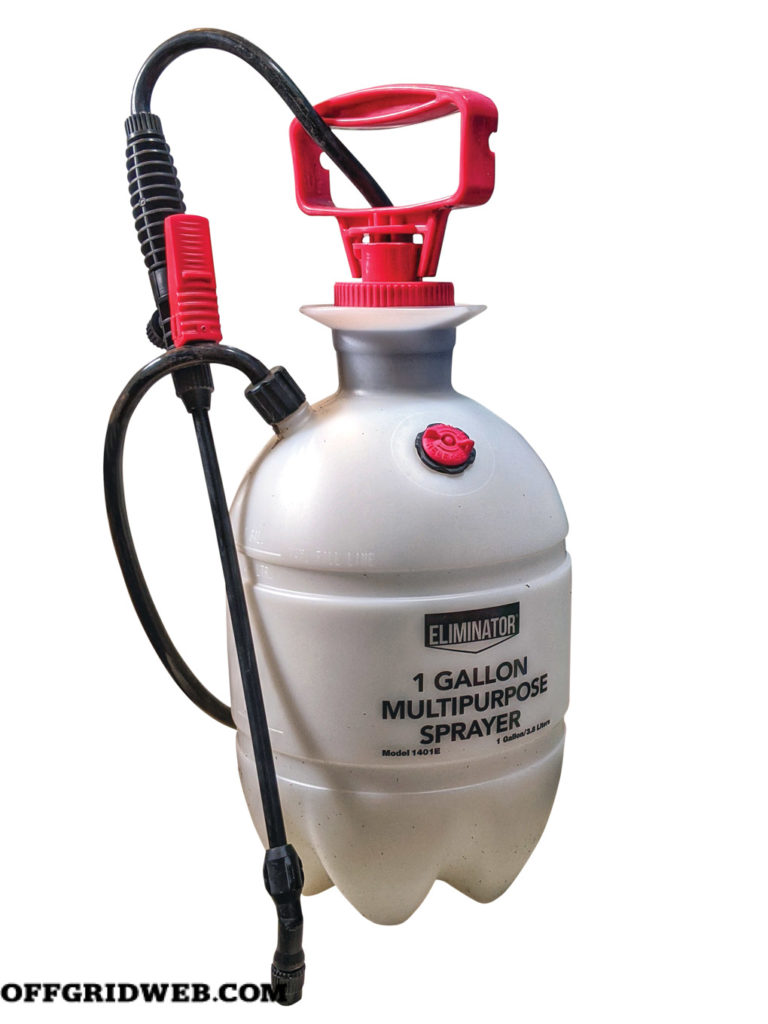
Above: A clean pressure sprayer filled with water can be placed near any toilet or latrine.
Liquid trash, excluding grease, can be dumped in soakage pits. To build a soakage pit, you dig a hole or trench similar to a latrine, but then fill it with rocks. Start with large stones in the bottom, and reduce to medium rocks in the middle, reducing size until the top layer is gravel. This graded fill allows the liquid waste to settle to the bottom without creating a nasty, disease-promoting, trash swamp. The concept of a soakage pit also works for building a urinal.
Reducing your trash output during a disaster can help too. Consider alternate or more complete use of everything. Evaluate all your trash for reuse — containers for water transport, washing stations, and other purposes. Clean paper trash for fire starting, lining waste containers, even improvised toilet paper. Food waste can be reduced by better use and preparing only the amount that’ll be eaten. Get creative with leftovers and use all the parts of plants and animals. This will provide more nutrition out of a given item, make food stocks last longer, and reduce the amount of waste. Dehydrating, canning, and other shelf-stable preservation methods will help to reduce spoilage.
Food prep and eating areas should be kept clean by removing large physical remnants of meals and wiping down all surfaces with soap and water or a bleach solution. Dishes should be washed thoroughly, though every effort to conserve water should be taken. Laving water over dishes, rather than filling an entire sink or basin, can reduce water use.
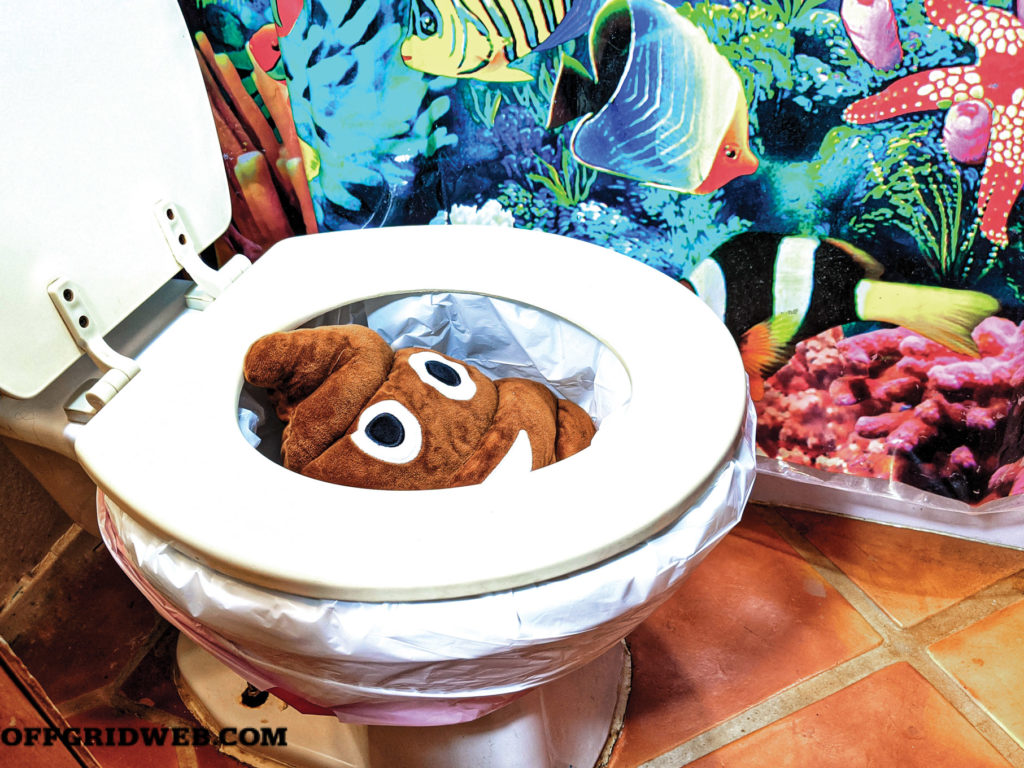
Above: Fitting a garbage bag into the emptied toilet bowl, with the seat closed over the opening, makes for a comfortable, easily maintained, toilet solution.
The final point is laundry. We’ve talked about keeping the body clean, and clean bodies require clean (or at least sanitized) clothes. We’ve also talked about numerous uses for fabric in waste management and cleanup. This means laundry must be done. The same clothes can be worn repeatedly, but for no more than 1 week. Items soiled with waste will need to be washed almost immediately, however. You can wash clothes entirely by hand in a bucket or tub. A few clothes at a time go into the bucket with water and detergent, and you agitate and scrub them one at a time by hand until the dirt and grime come out. Then, you repeat the process with clean water to get a thorough rinse. Devices like washboards can reduce fatigue while improving results.
One of the most effective labor savers for bucket or tub washing clothes is a plunger. There are several designs for laundry agitating plungers popular with homesteaders, but a new household toilet plunger works too. Insert the plunger into the bucket and plunge, making sure to fully agitate and compress all of the clothes within. Cutting or drilling some holes into the plunger can reduce resistance and increase the cleaning agitation. Clothes and fabric can also be disinfected, but not cleaned, by a 1- to 2-minute pass through boiling water. Leaving cloth items in direct sunlight for several days, turning them over halfway through, can also disinfect them.
Disaster survival means adaptation to the unfamiliar and the uncomfortable. For many of us, these methods will seem primitive and unattractive. The reality, however, is that they’re adequate to meet the needs of surviving until you can begin thriving, either through your own long-term solutions or the return of infrastructure and services. Non-flush toilets, wash basins and buckets, trash burial, and other improvised methods are the norm for millions of people worldwide. You can do this, maybe not with a smile, but you can do it and you will prevail.
Morgan Atwood is the founder of No One Coming, a firm providing services, tools, and education for survival environments. A dedicated wilderness professional, Atwood has been an EMT and wildland firefighter, provided risk management and anti-poaching services for remote ranches, and lived off grid on a historic cattle ranch most of his life. www.noonecoming.com
 STAY SAFE: Download a Free copy of the OFFGRID Outbreak Issue
STAY SAFE: Download a Free copy of the OFFGRID Outbreak Issue
No Comments